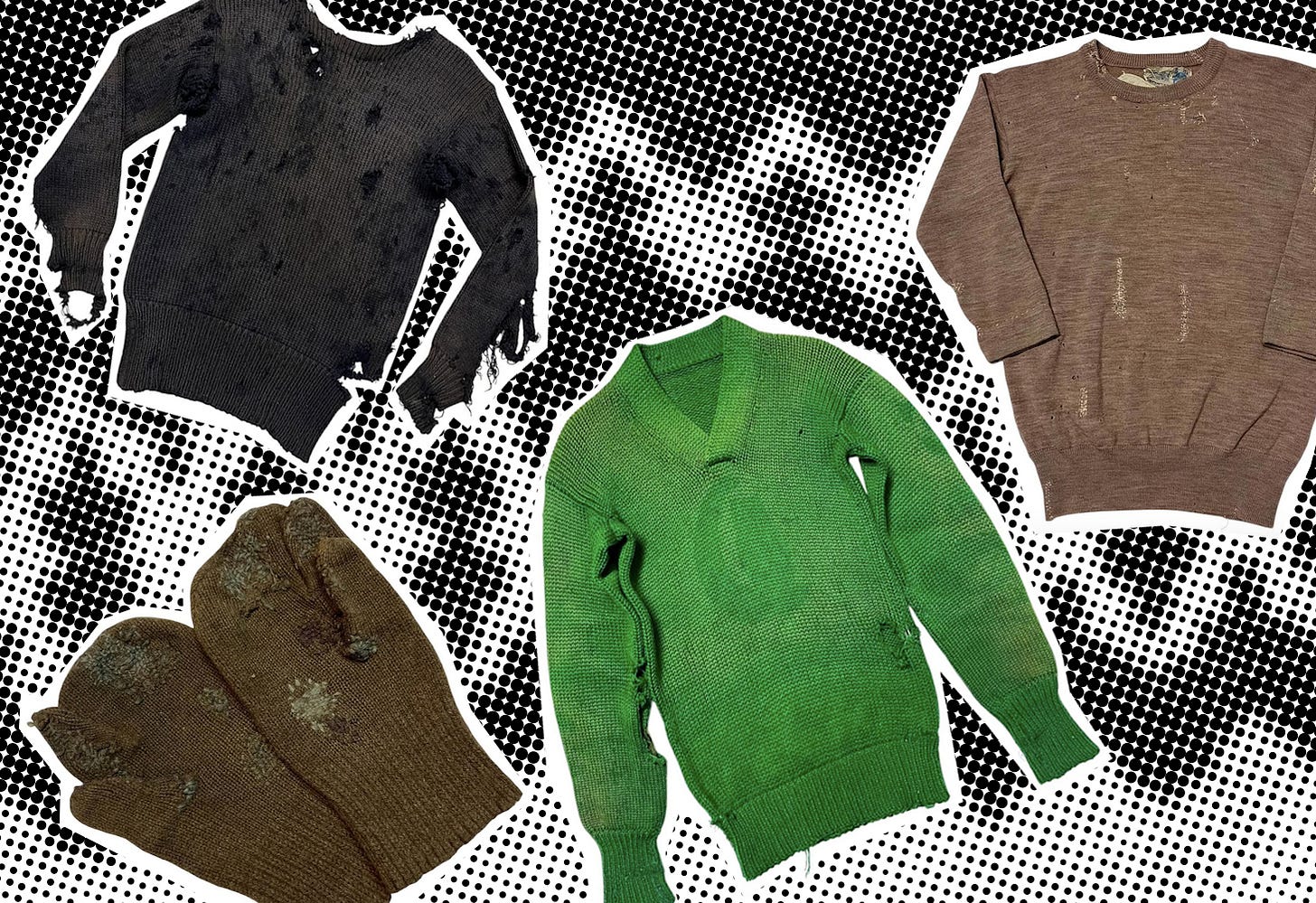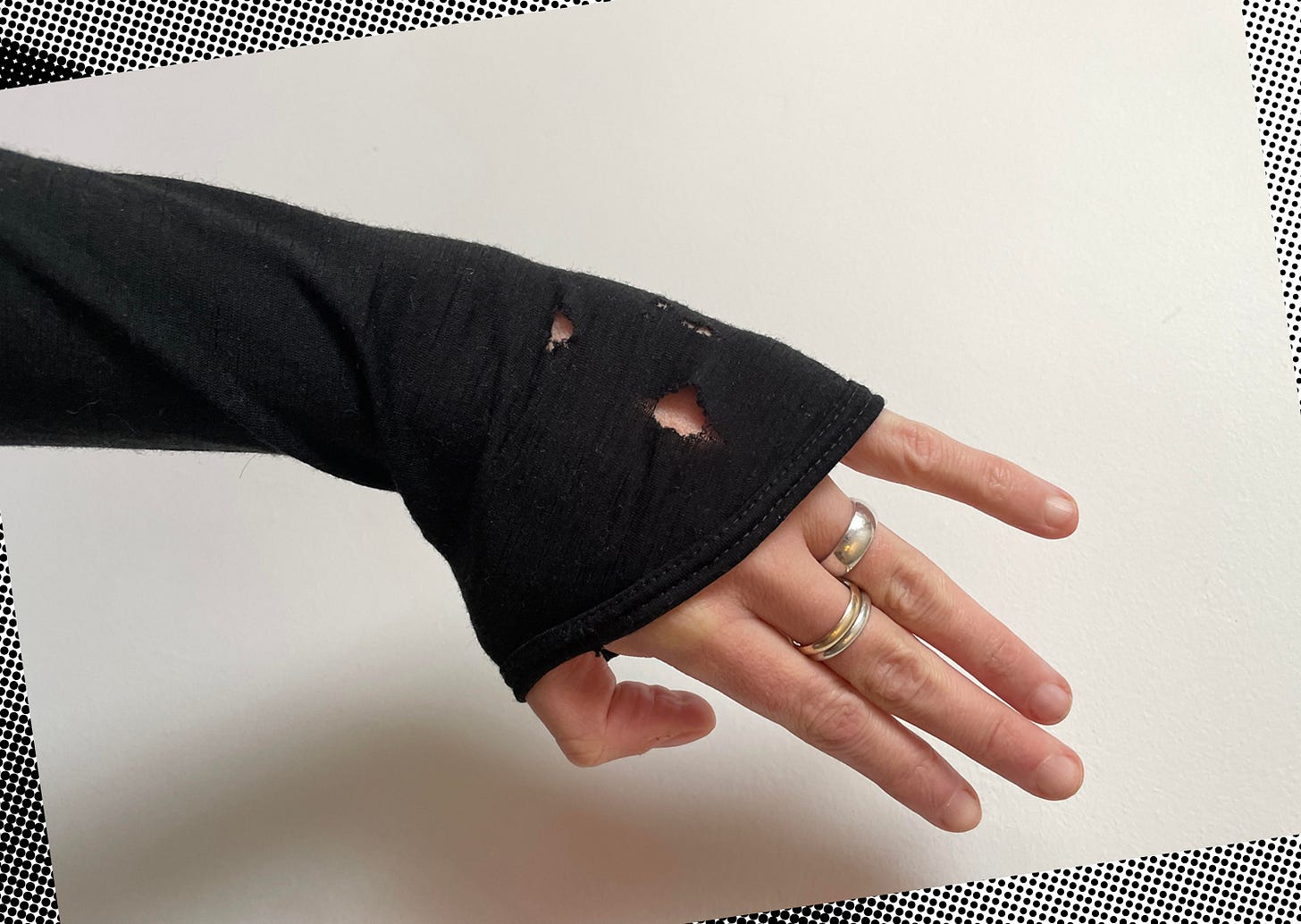Flaws, fallibility and shabby-chic semiotics
In which I predict moth holes as a status symbol and typos to be a sign of humanity.
Crust is a weekly newsletter on taste and culture from Tāmaki Makaurau.
It’s Easter weekend, so in the name of death and rebirth let’s think about damaged clothing. I also have notes on ballet-sneaker hybrids, hot cross buns and a bellwether of vape dominance in Aotearoa.
As someone who generally looks like they’ve been coughed up by a storage locker, it should surprise no one that I found myself with a moth situation. Those elegant, locally made cedar blocks can only do so much. (Frances Nation is the kind of shop where you buy hope.) They worked, well in fact, until they didn’t.
Feeling like it was a good day for the sex and sensibility of my Rachel Mills bralette —made from merino, complete with sleeves — I pulled it out of the cupboard to find it revealed more skin than last year; moths had been munching, and those telltale jagged holes littered the sleeves. A Kate Sylvester cardigan? Holes in that too. I frowned, cursed and chose acceptance.
Some garment-care authorities (Google) prescribe treatments and assign blame, and solutions-focused SEO content explains once again that I’m doing most things in my life incorrectly, because the internet trades in hyperbole and absolutes.
Upon discovery of moth holes it’s advised to put the beleaguered garment (bagged) in the freezer to kill the larvae, according to English Heritage — which blames the Romans for spreading the pest as they expanded their empire — before doing any darning.
People are very into that part, and there’s a sprawling network of avid menders sharing their darning work online. Some have made an art form of it, including Bridget Harvey whose moth-eaten merino jumper is with the V&A, but the best example I’ve seen so far is by Celia Pym.

Some insist moths are The Worst Thing That Will Ever Happen To Your Wardrobe, but I have no energy for histrionics and prefer acceptance to spinning out. Costume conservator Janet Wood calls them “grazing marks”, which sounds much better.
And besides, moth holes look cool (even cooler would be not writing this at all, but detached ambivalence isn’t a character trait I’ve managed to cultivate). Why not feel like a relic from another age, dug up from a peat bog or an arid steppe? How about a dashing dissident who distributes pamphlets with big ideas?
When the prevailing conventions are to look tidy and presentable — current iterations include “clean girl”, “quiet luxury” and “old money” — something that’s not offers a visual way to rock the boat.

What once suggested poverty and allowed for class appraisal was adopted by punk to signify disorder and dissatisfaction; holey jumpers are among what Dick Hebdige called a “catalogue of beautifully broken codes” in his seminal 1979 book Subculture: The Meaning of Style, also borrowing Umberto Eco’s concept of ‘semiotic guerilla warfare’ for subverting modes of convention. Imbued with new meaning and cultural cachet (before, inevitably, being commodified) these messy clothes shook up all the squares.
The early 1980s saw the countercultural Comme des Garçons and Vivienne Westwood both putting holes in all sorts of things (Rei reportedly did it by loosening the screws in the knitting machine) and pieces from this era go for huge sums on the resale market now. It’s not an understatement to say Rei — and Yohji, Martin, et al — changed fashion forever. By 2001 moths themselves were part of the unsettling tableau for Alexander McQueen’s famous Voss show.

But it’s not just outsiders and the subversively inclined that go in for a bit of wear and tear. “The quiet shabbiness among the very richest can appear illogical to the uninitiated,” writes W. David Marx in Status And Culture. Like an old Land Rover, a holey cashmere sweater (proper cashmere, mind you) communicates modesty, nonchalance and the generational wealth of heirlooms. “In the place of profligacy, they [the Old Money class] pursue ‘spartan wealth’ — austere choices that may seem nonluxurious at first glance.”
There are less subtle examples too. In 2011, Karl Lagerfeld scattered fake moth holes across Chanel tweed that, ironically, contained no wool in its tweed composition (The Met lists cotton, acrylic, nylon and polyester; a jacket from the collection, US$1890 on 1st Dibs, shows a tulle underlay). Which all kind of defeats the purpose — although maybe that’s the point — because what does a moth hole signify if not that one is wearing wool?
And herein lies my prediction; with an increasing amount of clothing made from synthetic fabrics — the last time I wrote abut this was 2023 — natural fibres have a certain cache for people who value that kind of thing, so I wouldn’t be surprised if moth holes became something of a status symbol or in-group signifier. In some cases it rests on class privelege, for others it’s antiestablishment, and sometimes both all at once at once.
Ultra-thrashed vintage is already having a moment in some circles, particularly overseas — GQ declared it “the hottest thing in fashion” last September.

“There is definitely a rise in content around thrashed and worn vintage,” agrees Juliet Stimpson of Noon Goods, pointing out a lot is geared towards a “vintage bro culture” of guys competing to show off their barn finds. (Lol). Given the condition, some prices can be eye-watering. “From an outsider’s perspective, they probably seem ridiculous and almost like the Derelicte collection in Zoolander.”
She doubts it will take off to such a level in Aotearoa. “For starters, there is just less of this very old, very worn vintage around to be worn, and there is also a much smaller market here,” Juliet says, though Swandri jackets always sell well here. “Even when really worn though.”
For those on the hunt, authentically thrashed pieces can be hard to find. “A lot of op shops won't put out worn or holey items if they notice the damage on them,” she explains. “But if you do like to find that kind of stuff, then tip shops and recycling centres will usually put them out and for cheap.” (I’d also try Ponsonby’s Search and Destroy for a curated range).
In this line of work, Juliet comes across moth damage on a regular basis. “The worst offenders to me are knitted cardigans and jumpers, especially the ones you don't notice immediately and then get home to find one hole and then another and another.” If she spots a damage while sourcing she’ll usually leave the item behind rather than add it to her mending pile. “But if it’s a small hole, or a really great piece, it might still come home with me.”
When it comes to her own wardrobe, she doesn’t mind moth holes, or noticeable wear. “There is definitely still opportunity for holey and thrashed items to be loved and worn,” she says. “There is something about wearing a lived-in item that feels a bit cosier, and kind of more luxurious than a new item. It's nice to know something has lasted and been loved enough to get worn, as opposed to being worn once or twice and then discarded.”
I buy the lion’s share of my jumpers second-hand, nearly always from Tony at Bad News, or after a country of origin search (Scotland) on eBay and Etsy. For new knitwear I like Rachel’s clingy merino base layers, plus Penny Sage and Standard Issue. Yesterday, in all that wind and rain, I stopped by Francie on Richmond Road to see their range — half of which is made here, and the other half in founder Anni Albers’ homeland of Australia — including an airy shrug (chic), fingerless gloves (cosy), a very generous scarf (classic) and a jaunty kerchief (cool). There was also a lot of great knitwear shown by young designers at Te Wiki Āhua O Aotearoa last month, and pretty much all of it, like the pieces from Cisco Bella, was distressed, deconstructed or upcycled.
Why do flaws appeal now? New clothes have never been cheaper, nor an infinity of styles easier to access, so visible markers of wear and time can be read as reactionary to mass production and awarenesss — what’s more niche than damaged vintage? Think of it as Shabby Chic Semiotics. Amidst all tensions of technological advancement and digital simulacra, the desire to collect these physical relics and touch the past grows stronger and more alluring.
We saw this in Alice Rohrwacher’s excellent La Chimera, both in the film’s plot — a troupe of Etruscan tomb robbers — and its design, with Josh O’Connor’s increasingly dirty linen suit and cinematographer Hélène Louvart’s use of Kodak 35mm and 16mm. It reminded me of Emir Kusturica’s films (watch Black Cat, White Cat and Time of the Gypsies if you haven’t already) — preoccupied as they are with the material decay of culture, community and the state.
Aesthetic decay is futuristic too; unplugged from the Matrix, Neo and the gang wore an assortment of distressed garb — someone asked Reddit why they all “wear rags, when they have the capacity to build flying submarines?” (a good question) — and there was dirty futurism in Twelve Monkeys too.
It’s only natural that material decay and wear-and-tear are resonating with people when you consider what else is going on right now.
The dystopic world of Rick Owens is finding new fans. His brand was the third most popular on Grailed last year, and his adolescently inflected Geobaskets, which turn 20 in 2026, are having a bit of a moment again (they play a critical part in Timothée’s current look).
On the topic of sneakers, an Instagram story by Lucy Zee alerted me to the fact that the infamously hard-to-find Nike Air Rifts (in my experience, when searching for a pair around 10 years ago) are back on the market in Melbourne at the likes of Hype DC and Up There, but it doesn’t look like they’ve made it across the Tasman — all my phone calls revealed no current stock.
It makes sense given the rise of sneakers-that-aren’t-sneakers lately. Low-profile sneakers have merged with the ballet flat renaissance, and Sandy Liang spun her darling Mary Janes off into a collaboration with Salomon last year. (Business of Fashion has Mary Janes and ballet flats growing faster than the entire high heel category).
Adidas have a ballet version of their Taekwondo that’s out here now, and in store at Karen Walker, so expect to see them everywhere over the coming months; Karishma Singh Kelsey was wearing Puma Speedcat Ballets when I saw her the other week; and my London-based sister said the style can be seen on scores of feet up there, since the weather has been good, and it’s mostly Adidas and Puma (and those Miu Miu Reeboks). This is all a revival of course, and if I were buying in, I’d go for some beat up Prada Sports. Material decay!
This week I’ve been:
Hearing… Beabeas’ hot cross buns are the “best in town now”, according to my neighbour, and Madeleine (Crust reader Lauren said queues on Thursday morning wrapped around the Westmere building). I hate hot cross buns so will always defer to Kim on this category.
Thinking…. about the use of Chat GPT as willful deskilling (we saw it from the 1980 as manufacturing went off shore, now we’re in a position where you can’t put the genie back in the bottle, and experts are saying America probably couldn’t make their own smart phones even if they want to) and how typos are a sign of the human hand — I make plenty here, and even Tina Brown has some. I have a working theory that writing will become intentionally mispelled and miscased to signal it’s not the work of AI. Anyway, remember when we all wRoTe LiKe tHiS?
Borrowing… Black Ivy: A Revolt In Style from the library ahead of May 5 because I like doing homework.
Pumped… about news of the new Pride and Prejudice adaptation (Emma Corrin, Olivia Colman, Dolly Alderton) and a glimpse of Jacob Elordi’s gold-toothed Heathcliffe. Is it a romanticism revival or are tensions of class and gender timely?
Wondering… if a bellwether of vape dominance is Red Seal’s recent (?) rebrand of its ‘Smokers’ toothpaste. What was overt and old world is now ‘strong mint’.
Listening… to Hari Nef talk to the Nymphet Alumni girls about the heady era of fashion in 2010s New York, adolescent posting on live journal, finding community — and yourself — on a free-er internet.
Watching… the new season of The Last of Us, speaking of material decline and social upheavel.
New here? Catch up on Crust.
If ASMR’s your thing then I have the skirt for you. (A sensory edition that goes from haute to horror.)







The next update to the AI model will see it intentionally misspell and miscase words to signal it’s not the work of AI.
So many delicious, rich references here, ty, I feel so well fed. Moths are the bane of my life. Sadly I simply do not vacuum my home with enough ambition required to break the cycle. Tho I will say: parasitic wasps. They’ve helped me. (And probably could have broken the cycle if, you know, I’d vacuumed every day or whatever lol)
Also this line will continue to nibble away at my brain: “I wouldn’t be surprised if moth holes became something of a status symbol or in-group signifier.” I’m persuaded!